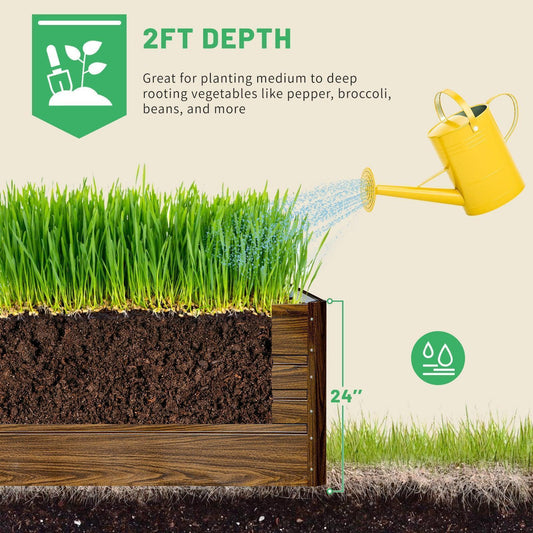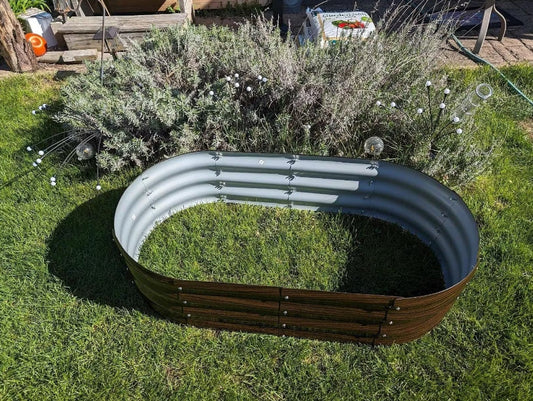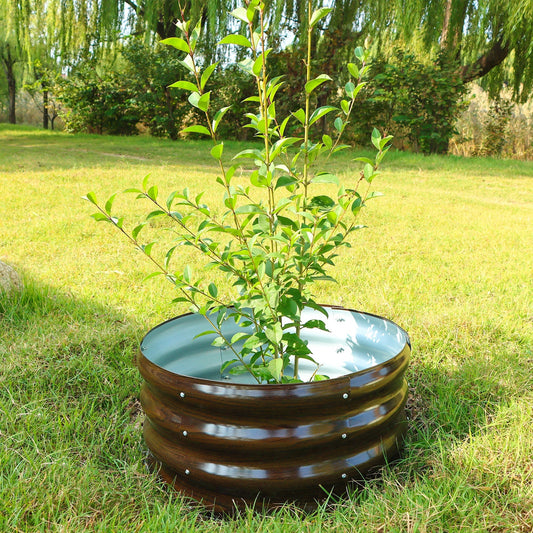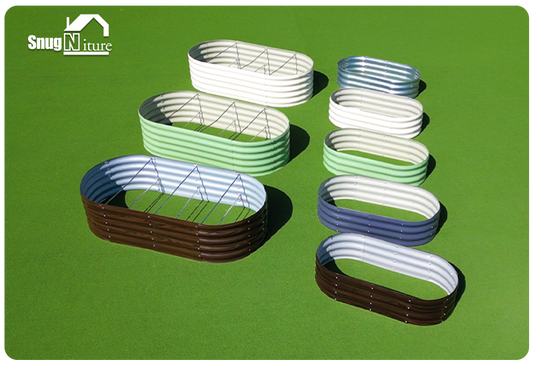How to Pick the Perfect Raised Garden Bed for Your Backyard
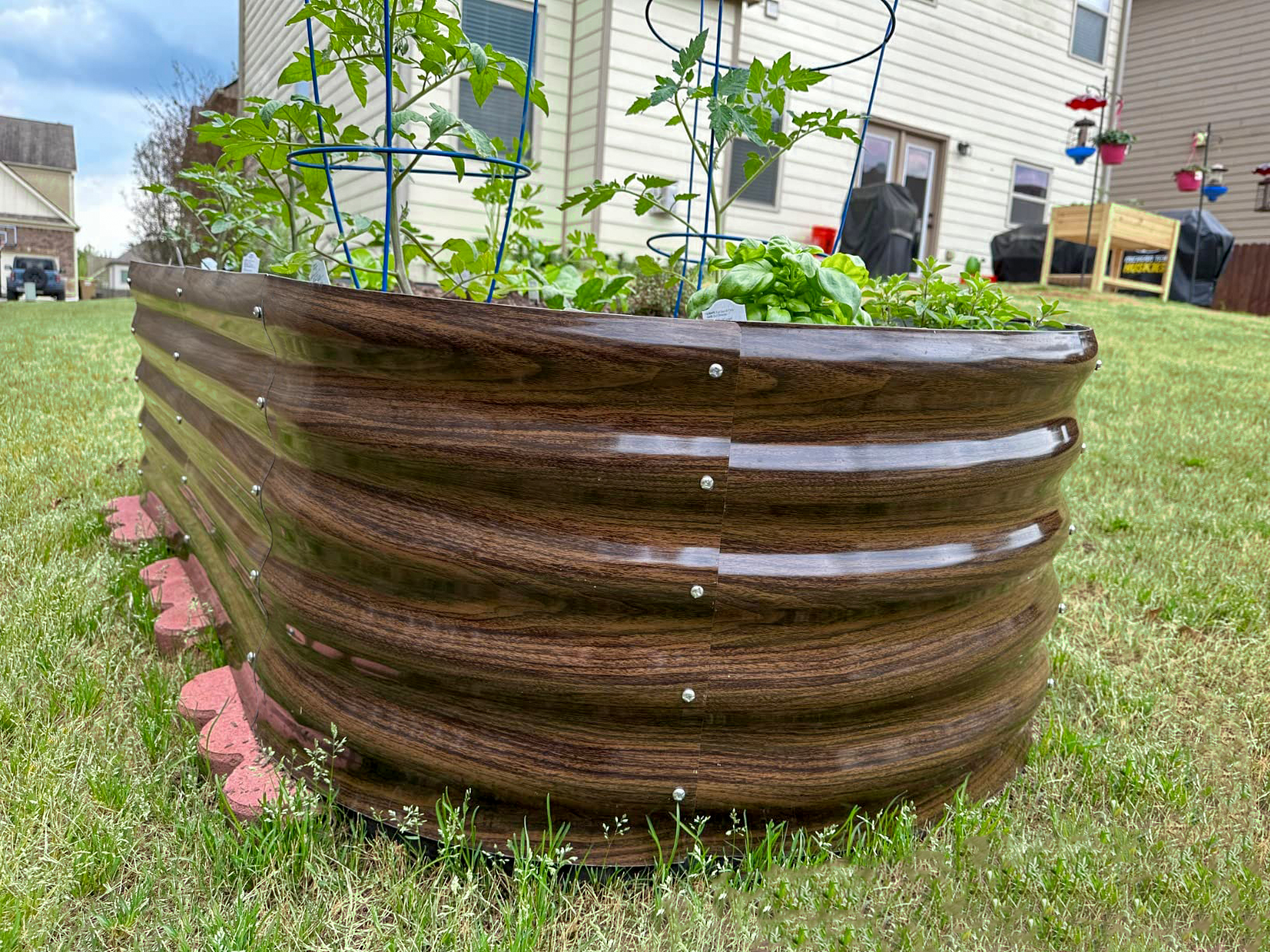
Imagine stepping into your backyard and seeing a vibrant, thriving garden that’s easy to maintain and perfectly suited to your space. That’s the magic of the best raised garden bed. These versatile gardening solutions offer so many benefits. You get improved soil quality and drainage, which means healthier plants. They also warm up faster, letting you start planting earlier and enjoy a longer growing season. Plus, their flexible designs make them a great fit for almost any backyard layout. Whether you’re growing vegetables, flowers, or herbs, the right raised garden bed can transform your outdoor space into a gardener’s paradise.
Key Takeaways
Raised garden beds help soil stay healthy and drain well. This helps plants grow better and stronger.
They make gardening simpler by lowering the need to bend or kneel. This makes them easy for anyone to use.
Pick strong materials like wood, metal, or stone. Each has good and bad points.
Think about the size and shape of your bed. This helps save space and makes it easy to reach your plants.
Choose designs that can grow bigger later. This lets your garden expand as you need more space.
Benefits of Raised Garden Beds
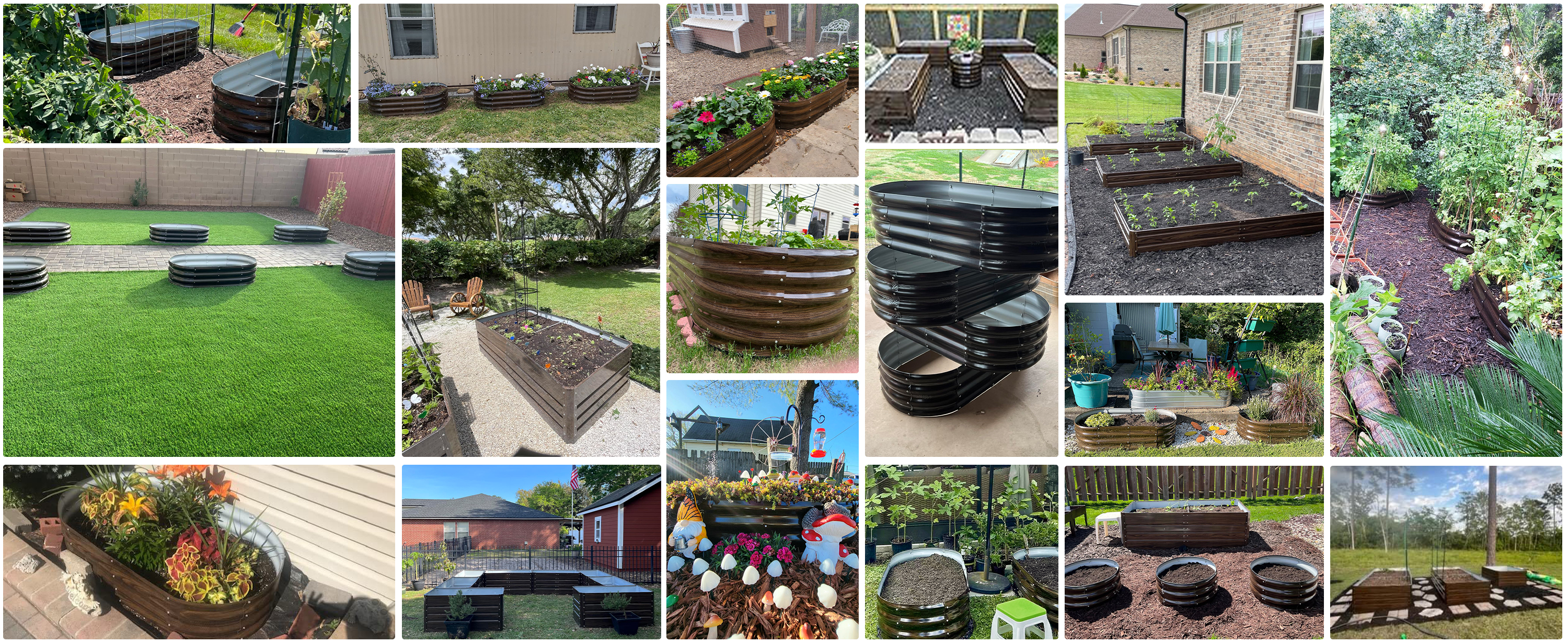
Improved Soil Quality and Drainage
One of the biggest perks of a raised garden bed is the control it gives you over soil quality. If your backyard soil is rocky, clay-heavy, or even contaminated with pesticides, you don’t have to worry. Raised beds let you start fresh with nutrient-rich soil, like sandy loam, which is loose, well-draining, and packed with organic matter. This type of soil ensures your plants get the oxygen and nutrients they need for healthy root growth.
Raised garden beds also solve drainage issues. If your yard has heavy clay soil that holds too much water or sandy soil that drains too quickly, a raised bed can fix that. Studies show that raised beds improve drainage in both types of soil, creating the perfect environment for your plants to thrive. You’ll notice healthier, more vibrant growth in no time.
Easier Maintenance and Accessibility
Gardening doesn’t have to be back-breaking work. Raised garden beds make it easier to manage your plants without constant bending or kneeling. You can even build them at heights like 24 or 30 inches, making them perfect for wheelchair users or anyone with mobility challenges. Imagine tending to your garden while standing comfortably—it’s a game-changer!
Raised beds also simplify maintenance. You can control the soil quality, rotate crops easily, and even set up efficient watering systems. Plus, they help protect your plants from pests like rabbits or deer, cutting down on the need for constant pest control. With less effort, you’ll enjoy a flourishing garden.
Pest and Weed Control
Tired of battling pests and weeds? Raised garden beds can help. They create a physical barrier that keeps many pests, like slugs, aphids, and tomato hornworms, at bay. You can also use fresh, weed-free soil and add barriers like landscape fabric or cardboard to stop weeds from creeping in.
Mulching is another great trick. It suppresses weed growth while keeping your soil moist and healthy. With these methods, you’ll spend less time pulling weeds and more time enjoying your garden. Raised bed gardening truly makes container gardening and vertical gardening easier and more enjoyable.
Aesthetic and Functional Appeal
Raised garden beds don’t just make gardening easier—they can also transform your backyard into a stunning outdoor retreat. With the right design, they become more than just a place to grow plants. They can serve as eye-catching focal points that elevate the entire look of your space.
Want to add some personality to your garden? Unique shapes like circular or L-shaped beds can create visual interest and break away from the traditional rectangular designs. Tiered beds are another great option. They add height and depth, making your garden feel more dynamic. You can even incorporate vibrant colors or mix materials like wood and metal to create a striking contrast. These small touches make your garden beds stand out while blending beautifully with the rest of your backyard.
By creating artistically designed raised bed garden spaces, unruly vegetables are contained, edible flowers and pollinator plants add beauty, and the raised bed becomes an attractive focal point in the garden.
Raised beds also bring functional benefits to your backyard. They help you make the most of your space by providing a controlled growing environment. You can manage soil quality, drainage, and plant spacing with ease. Plus, they’re perfect for organizing your garden. Whether you’re growing vegetables, herbs, or flowers, everything stays neat and accessible.
These beds can even serve double duty. Use them as privacy screens to hide unsightly areas or create cozy, secluded spots in your yard. Strategically placed raised beds can act as natural barriers, helping you define different zones in your outdoor space. And don’t forget the charm of vining plants like tomatoes or cucumbers. Their tendrils drape elegantly over the sides, adding a touch of natural decor that’s hard to beat.
With raised garden beds, you’re not just growing plants—you’re designing a backyard that’s as functional as it is beautiful.
Key Factors to Consider for the Best Raised Garden Bed
Choosing the right raised garden bed involves more than just picking a design you like. You’ll need to think about materials, size, shape, drainage, and soil depth to ensure your garden thrives. Let’s break it down.
Materials
The material you choose affects the durability, cost, and appearance of your raised garden bed. Here’s a quick guide to the most popular options:
Wood (e.g., cedar, redwood)
Wood is a classic choice for raised garden beds. It’s affordable, easy to work with, and gives your garden a natural, rustic look. Cedar and redwood are especially popular because they resist rot and insects better than other types of wood. However, wood does require regular maintenance and has a shorter lifespan compared to other materials. Untreated wood is also more eco-friendly but may break down faster.
Metal (e.g., Snugniture Modular Metal Raised Garden Bed)
Metal raised garden beds, like the Snugniture Modular Metal Raised Garden Bed, are incredibly durable and can last up to 30 years with proper care. They resist rot, pests, and extreme weather, making them a great long-term investment. Plus, their sleek, modern look can elevate your backyard’s aesthetic. Just keep in mind that metal can heat up in hot climates, so you’ll want to monitor soil temperature during summer.
Plastic and Composite Materials
Plastic and composite materials are lightweight and budget-friendly. They’re also resistant to rot and insects, making them low-maintenance. However, they lack the charm of wood or metal and may not be the most sustainable option. If you’re looking for a quick and easy solution, plastic might work, but it’s not the most durable choice.
Stone or Concrete Options
For maximum durability, stone and concrete are hard to beat. These materials can last indefinitely and handle extreme weather with ease. They’re also visually striking, giving your garden a timeless, elegant feel. The downside? They’re heavy, expensive, and not as easy to move or adjust once installed.
Tip: If you live in an area with harsh weather, consider stone or metal for their longevity and resilience.
Size and Shape
The size and shape of your raised garden bed play a big role in how easy it is to use and how well your plants grow.
Standard Sizes and Heights (e.g., 12", 17", 24")
Most raised garden beds are 12 to 24 inches tall, which is perfect for most plants. Taller beds, like 24 inches, are great if you want to avoid bending over or if you’re growing deep-rooted plants like tomatoes. For width, aim for no more than 4 feet so you can reach the center without stepping on the soil. Lengths of 10 to 12 feet work well for structural stability.
Custom Shapes for Unique Spaces
Got an irregular backyard? Custom-shaped raised garden beds can help you make the most of your space. Circular, L-shaped, or U-shaped designs not only optimize planting areas but also add visual interest. For example, a fenceline garden with tiered beds can maximize small spaces while creating a stunning focal point.
Drainage and Soil Depth
Proper drainage and soil depth are essential for healthy plants.
Ensuring Proper Drainage
Good drainage prevents water from pooling and drowning your plants. To improve drainage, you can aerate the soil with a hand tiller or add compost to enhance its structure. Another option is to use a high-quality raised bed mix or try the hugelkultur method, which layers organic materials like logs and branches at the bottom of the bed.
Ideal Soil Depth for Different Plants
Different plants have different root depth needs. Compact herbs like basil only need about 6 to 8 inches of soil, while vegetables like kale or eggplant thrive in 12 to 18 inches. For deep-rooted plants like carrots, aim for at least 24 inches of soil depth. Knowing your plants’ needs will help you choose the right bed height and ensure they grow strong and healthy.
Pro Tip: The top 6 inches of soil are the most nutrient-rich, so make sure to replenish it regularly with compost or organic matter.
Ease of Assembly
Pre-Made Kits vs. DIY Raised Garden Bed Options
When it comes to setting up your raised garden bed, you’ve got two main options: pre-made kits or DIY. Each has its perks, but one might suit your needs better than the other. Here’s a quick comparison to help you decide:
Advantage |
Pre-Made Kits |
DIY Options |
|---|---|---|
Ease of Assembly |
Simple and quick to assemble |
Can be complex and time-consuming |
Material Quality |
Durable materials like cedar and hemlock |
Often cheap, thin lumber or metal |
Longevity |
Estimated to last 10-15 years |
May warp, rust, or rot quickly |
Support for Infrastructure |
Can support additional structures |
Limited support for additional features |
Convenience |
Convenient online shopping and fast shipping |
Requires more effort and planning |
If you’re short on time or prefer convenience, a garden bed kit is the way to go. These kits come with everything you need and are designed for easy assembly. On the other hand, DIY options let you customize your bed’s size and shape, but they require more effort and planning.
Tools and Skills Required
Whether you choose a garden bed kit or a DIY project, you’ll need some basic tools and skills to get started. Here’s what you’ll likely need:
Tools:
Raised bed materials (e.g., cedar boards, bricks, steel siding)
Bed hardware (e.g., screws, washers, framing angles)
Drill
Tape measure
Bolt tightener
Sod cutter or similar equipment to clear the space
Skills:
Measuring and cutting materials accurately
Using a drill and other basic tools
Following assembly instructions or building plans
For pre-made kits, the process is straightforward and beginner-friendly. DIY projects might require more advanced skills, but they’re a great way to flex your creativity.
Durability and Longevity
Weather Resistance
The durability of your raised garden bed depends heavily on its ability to withstand the elements. Materials like Western Red Cedar are naturally resistant to rot, making them an excellent choice for long-lasting garden beds. Metal options, such as those in a garden bed kit, resist rust and corrosion, ensuring they hold up well in humid or rainy climates.
Weather resistance plays a key role in how your garden bed endures humidity, rainfall, and temperature changes. Proper drainage and placing your bed on gravel instead of grass can also extend its lifespan.
Maintenance Requirements
To keep your raised garden bed in top shape, regular maintenance is essential. Here are some tips to help you maximize its longevity:
Add a two-inch layer of compost or organic material every spring and fall to replenish nutrients.
Use reinforcing rods to stabilize the structure against soil expansion during freezing and thawing.
Rotate 25% of your bed space into cover crops annually to maintain soil fertility.
For wooden beds, apply a stain or sealant periodically to protect against moisture and pests.
Composite materials, like woodcrete, require minimal upkeep, while wood and metal beds benefit from occasional care. With proper maintenance, your garden bed can last for years, giving you a thriving garden season after season.
Types of Raised Garden Beds
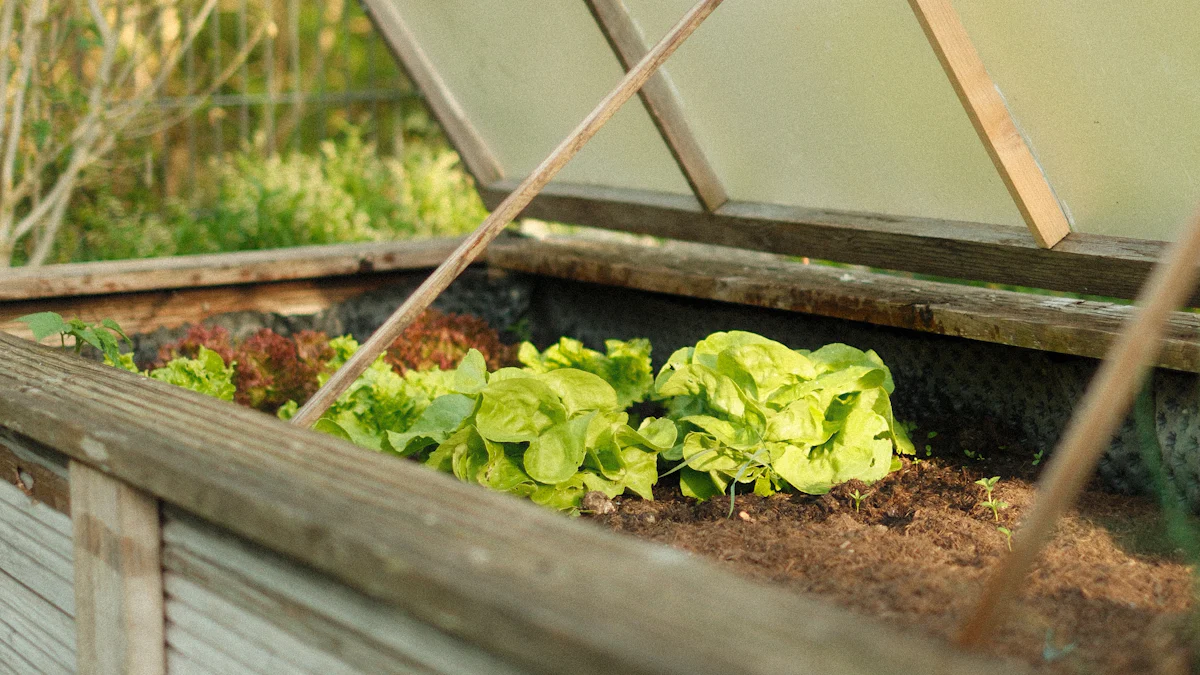
Wooden Raised Garden Beds
Pros and Cons of Wooden Beds
Wooden raised garden beds are a favorite among gardeners for their natural charm and versatility. They blend seamlessly into any backyard, giving your garden a rustic, organic feel. You can easily customize them to fit your space, whether you want a small square bed or a long rectangular one. Plus, wood provides excellent insulation, protecting your plants from extreme temperatures.
However, wooden beds require regular maintenance. Over time, they can rot or warp, especially if exposed to constant moisture. Untreated wood is more eco-friendly but has a shorter lifespan. If you’re looking for a low-maintenance option, wood might not be the best choice.
Best Wood Types for Longevity
If you decide on wood, go for durable types like cedar or redwood. These woods resist rot and insect damage better than others, making them ideal for outdoor use. Treated wood lasts longer but may contain chemicals that could leach into the soil. Always choose untreated or naturally rot-resistant wood for growing edible plants.
Metal Raised Garden Beds
Benefits of Metal Beds (e.g., Snugniture Modular Metal Raised Garden Bed)
Metal raised garden beds, like the Snugniture Modular Metal Raised Garden Bed, are built to last. They resist rot, pests, and harsh weather, making them a smart long-term investment. Their sleek, modern design adds a contemporary touch to your backyard. Metal beds also absorb and retain heat, which can help extend your growing season in cooler climates.
The modular design of Snugniture beds allows you to customize your layout, making them perfect for container gardening. With options like 12", 17", and 24" heights, you can choose the best size for your plants and your comfort. These beds are also eco-friendly, with Snugniture donating 1% of sales to tree planting initiatives.
Common Concerns (e.g., heat retention)
While metal beds are durable, they can heat up quickly in hot climates. This might cause soil to dry out faster, so you’ll need to monitor moisture levels closely. Adding mulch or shade cloth can help keep the soil cool. Some gardeners worry about rust, but high-quality metal beds, like Snugniture’s, are corrosion-resistant and designed to withstand the elements.
DIY Raised Garden Beds
Creative DIY Ideas
Building your own raised garden bed is a fun and rewarding project. You can repurpose old items like bookcases or pallets to create unique, budget-friendly beds. Natural materials like logs or rocks can also make beautiful, rustic beds. For a modern twist, try using corrugated metal sheets paired with wooden frames. The possibilities are endless, and you can design a bed that perfectly fits your space and style.
Cost-Effective Materials for DIY
If you’re on a budget, look for upcycled materials. Old pavers, stones, or even bricks from local landscaping stores can be affordable options. Logs and rocks found in your yard or nearby woods are another cost-effective choice. These materials not only save money but also add a personal touch to your garden. A DIY raised garden bed is a great way to combine creativity with practicality.
Tip: When building a DIY bed, make sure the materials are safe for growing food. Avoid treated wood or materials that might leach harmful chemicals into the soil.
Elevated Raised Garden Beds
Ideal for Small Spaces or Mobility Needs
If you’re short on space or need a more accessible gardening option, elevated raised garden beds are a fantastic choice. These beds are designed to sit higher off the ground, making them perfect for patios, balconies, or small backyards. You can grow a variety of plants without worrying about taking up too much room.
Elevated beds are also a game-changer for anyone with mobility challenges. Their convenient height means you don’t have to bend or kneel while gardening. This makes them ideal for older adults or anyone who finds traditional gardening physically demanding. You can enjoy planting, watering, and harvesting while standing or sitting comfortably.
Another bonus? Elevated beds improve drainage and soil aeration. Water doesn’t pool at the bottom, so your plants’ roots stay healthy and strong. Plus, the height helps keep pests like rabbits and slugs away from your plants. It’s a win-win for both you and your garden!
Popular Elevated Bed Designs
When it comes to elevated beds, you’ve got plenty of stylish and functional designs to choose from. One popular option is the elevated planter with built-in legs. These planters are compact and easy to move, making them perfect for small spaces. They often come with shelves underneath for storing tools or pots, adding extra convenience.
Another great design is the tiered elevated bed. This style gives you multiple levels for planting, which is perfect if you want to grow a mix of flowers, herbs, and vegetables. The tiered look also adds depth and visual interest to your garden.
For a modern touch, consider metal or composite elevated beds. They’re durable, sleek, and weather-resistant. Wooden designs, on the other hand, bring a rustic charm to your space. No matter your style, there’s an elevated bed that will fit your needs and make your garden shine.
Tip: Look for elevated beds with drainage holes or liners to keep your plants healthy and thriving.
Budget Considerations for Raised Garden Beds
Affordable Options
If you’re looking for budget-friendly raised garden beds, you’ve got plenty of choices. Wood is one of the most affordable materials. It’s easy to find and gives your garden a natural, rustic vibe. However, wooden beds may need replacing more often than other materials, especially if they’re untreated. While building your own wood bed can save money, sometimes the cost of materials adds up, making pre-assembled options more practical.
For even cheaper solutions, consider small raised beds made from fabric or other lightweight materials. These can cost under $100 and are perfect for beginners or small spaces. One great example is the Best Choice Mobile Raised Garden Bed, which offers convenience and affordability at just over $100. If you’re handy, DIY options using upcycled materials like pallets or old bricks can also help you save while adding a personal touch to your garden.
Mid-Range Options
If you’re ready to invest a bit more, mid-range garden bed kits offer a balance of durability and price. These kits often feature materials like cedar, composite wood, or galvanized steel, which last longer than basic wood or fabric beds. They’re also designed for easy assembly, saving you time and effort.
Many mid-range options fall between $200 and $300, giving you a durable and stylish solution without breaking the bank. For example, a cedar garden bed kit not only resists rot but also looks great in any backyard. Metal kits, like those made from galvanized steel, are another excellent choice. They’re sturdy, weather-resistant, and often come in modular designs, allowing you to expand your garden over time.
Premium Options
For those who want the best of the best, premium raised garden beds are worth considering. These options use high-end materials like stone, concrete, or powder-coated metal. They’re built to last for decades and can handle extreme weather with ease. Custom designs are also available, letting you create a garden bed that perfectly fits your space and style.
Premium garden bed kits often include features like built-in irrigation systems or tiered designs for added functionality. While these options can cost $500 or more, they’re a long-term investment in both durability and aesthetics. If you’re serious about gardening and want a bed that stands out, a premium option might be the perfect choice for you.
Tip: When choosing a raised garden bed, think about how long you plan to use it. Spending a bit more upfront can save you money in the long run by reducing replacement costs.
Balancing Cost with Longevity
When picking a raised garden bed, you want something that fits your budget but also lasts for years. Striking the right balance between cost and durability can save you money and effort in the long run. So, how do you make the best choice? Let’s break it down.
Start by thinking about materials. Cedar is a fantastic option if you’re looking for something durable and attractive. It resists rot and pests, making it a great long-term investment. While cedar costs more upfront, it pays off by lasting longer than cheaper woods. If you’re on a tighter budget, untreated wood is a solid alternative. It’s affordable and safe for growing food since it doesn’t contain chemicals. Just keep in mind that untreated wood might not last as long, especially in wet climates.
Metal beds, like galvanized steel, offer a middle ground. They’re moderately priced and incredibly durable. You won’t have to worry about rot or pests, and they can handle harsh weather. For something even sturdier, stone beds are the ultimate choice. They’re practically indestructible and add a timeless look to your garden. However, stone beds come with a hefty price tag and require more effort to install.
Tip: Use thicker boards (at least two inches) for wooden beds. They’ll hold up better over time and reduce the need for replacements.
If you’re looking for a more temporary or budget-friendly option, consider fabric grow bags or clay containers. These are perfect for small spaces or seasonal gardening. While they’re not as durable, they’re easy to set up and move around.
By weighing your options and thinking about how long you’ll use your garden bed, you can find the perfect balance between cost and longevity. A little planning now can save you from replacing your garden bed every few years.
Tips for Choosing the Best Raised Garden Bed for Your Space
Assessing Your Backyard Layout
Sunlight and Shade Considerations
Your plants need the right balance of sunlight and shade to thrive. Most vegetables and flowers require at least six hours of direct sunlight daily. When choosing a spot for your raised garden bed, look for areas in your backyard that get plenty of sun. Avoid placing beds near tall fences, trees, or buildings that might cast shadows. If you’re planning vertical gardening with trellises or arbors, position them carefully so they don’t block sunlight from reaching other plants.
Available Space for Gardening
The size and shape of your backyard will influence your raised bed gardening setup. Beds should be no wider than four feet so you can easily reach the center without stepping on the soil. If space is tight, consider container gardening or vertical gardening to maximize your growing area. Make sure pathways between beds are wide enough for easy movement, especially if you’ll be using tools or a wheelbarrow.
Matching the Bed to Your Gardening Goals
Growing Vegetables vs. Flowers
Your gardening goals will determine the best raised garden bed for your needs. If you’re starting a vegetable garden, raised beds improve drainage and prevent waterlogging, which is crucial for healthy crops. They also reduce weed growth and soil compaction, giving your plants better access to nutrients. For flowers, decorative raised beds can add charm to your backyard while keeping your blooms organized and accessible.
Seasonal vs. Year-Round Gardening
Think about how often you’ll use your garden. Raised beds warm up faster in spring, letting you plant earlier and enjoy a longer growing season. For year-round gardening, choose materials like metal or stone that can withstand harsh weather. You can also rotate crops seasonally, planting cooler-season vegetables like bok choy in spring and switching to heat-loving plants like tomatoes in summer.
Planning for Future Expansion
Modular and Expandable Options (e.g., Snugniture Modular Design)
If you’re planning to grow your garden over time, modular raised garden beds are a smart choice. Designs like the Snugniture Modular Metal Raised Garden Bed let you customize and expand your layout as needed. You can start small and add more sections later, experimenting with different planting arrangements. This flexibility makes modular beds perfect for both beginners and experienced gardeners.
Long-Term Gardening Plans
Think about your long-term goals. Are you aiming for a small vegetable garden or a large, diverse planting area? Durable materials like galvanized steel or stone are ideal for long-term use. They resist weather damage and require minimal maintenance. Planning ahead ensures your raised bed gardening setup grows with you, saving time and money in the future.
Tip: Modular designs and vertical gardening techniques make it easy to adapt your garden as your needs change.
Raised garden beds are a fantastic way to elevate your gardening experience. They give you better control over soil quality, improve drainage, and make maintenance easier. Plus, they can transform your backyard into a beautiful and productive space. Whether you’re growing vegetables, flowers, or herbs, the right raised garden bed helps you maximize your harvest while keeping pests and weeds at bay.
When choosing the best raised garden bed, think about materials, size, and your gardening goals. High-quality beds not only last longer but also enhance the look of your garden. They allow for healthier plants, easier crop rotation, and better water control. With a little planning, you can create a thriving garden that fits your space and needs perfectly.
Start small or go big—either way, a raised garden bed is a smart investment for a greener, more vibrant backyard.



